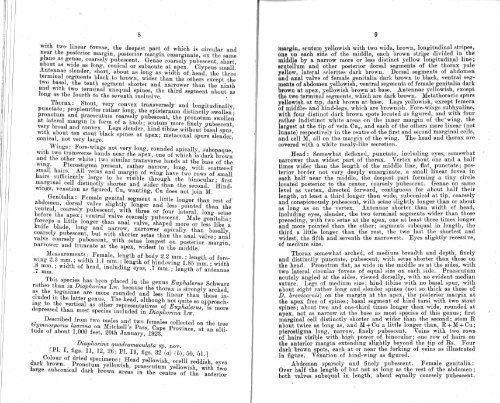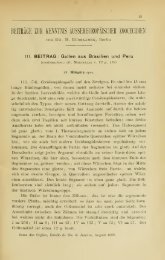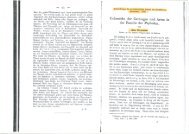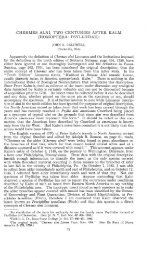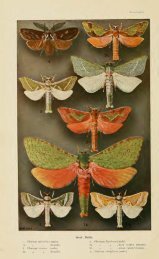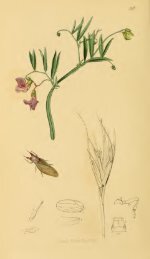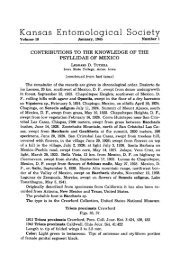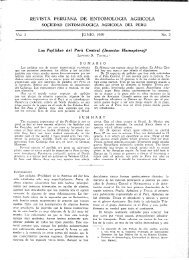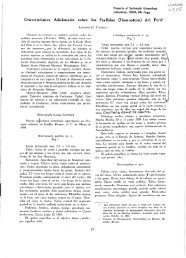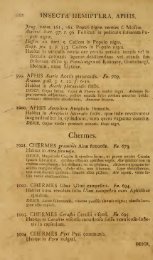ENTOMOLOGY MEMOIRS
ENTOMOLOGY MEMOIRS
ENTOMOLOGY MEMOIRS
You also want an ePaper? Increase the reach of your titles
YUMPU automatically turns print PDFs into web optimized ePapers that Google loves.
9<br />
with two linear foveae, the deepest part of which is circular and<br />
near the posterior margin, posterior margin emarginate, on the same<br />
plane as genae, coarsely pubescent. Genae coarsely pubesc ent, short,<br />
about as wide as long, conical or subacute at apex. Clypeus small.<br />
Antennae slender, short, about as long as width of head, the three<br />
terminal segments black to brown, wider than the others except the<br />
two basal, the tenth segment shorter and narrower than the ninth<br />
and with two terminal unequal spines, the third segment about, as<br />
long as the fourth to the seventh inclusive.<br />
Thorax: Stout, very convex transversely and longitudinally,<br />
punctate; propleurites rather long, the episternum distinctly swollen;<br />
pronotum and praescutum coarsely pubescent, the pronotum swollen<br />
at lateral margin in form of a knob; scutum more finely pubescent,<br />
very broad and convex. Legs slender, hind tibiae without basal spur,<br />
with about ten stout black spines at apex; metacoxal spurs slender,<br />
conical, not very large.<br />
Wings : Fore-wings not very long, rounded apically, subopaque,<br />
with two transverse bands near the apex, one of which is dark brown<br />
and the other white; two similar transverse bands at the base of the<br />
wing. Pterostigma present, rather narrow, long, with scattered<br />
small hairs. All veins and margin of wing have two rows of small<br />
hairs sufficiently large to be visible through the binocular ,• first<br />
marginal cell distinctly shorter and wider than the second. ifindwings,<br />
venation as figured, Cu, wanting, Cu does not join M.<br />
Genitalia : Female genital segment a little longer than rest of<br />
abdomen, dorsal valve slightly longer and less pointed than the<br />
ventral, coarsely pubescent, with three or four lateral, long setae<br />
before the apex; ventral valve coarsely pubescent. Male genitalia;<br />
forceps a little longer than anal valve, shaped more or less like a<br />
knife blade, long and narrow, narrower apically than basally,<br />
coarsely pubescent, but with shorter setae than the anal valve; anal<br />
valve coarsely pubescent, with setae longest on posterior margin,<br />
narrower and truncate at the apex, widest in the middle.<br />
Measurements : Female, length of body 2.2 mm. ; length of forewing<br />
2.3 mm.; width 1.1 mm. ; length of hind-wing 1 85 mm ; width<br />
.8 mm ; width of head, including eyes, .7 mm.; length of antennae<br />
.7 mm.<br />
This species has been placed in the genus Euphalerus Schwarz<br />
rather than in Diaphorina Lw. because the thorax is strongly arched,<br />
as the tegminae are more rounded and less linear than those included<br />
in the latter genus. The head, although not quite so approaching<br />
to the vertical as other representatives of Euphalerus, is more<br />
depressed than most species included in Diaphorina Lw.<br />
Described from two males and two females collected on the tree<br />
Gymnosporia laurina on Mitchell's Pass, Cape Province, at an altitude<br />
of about 1,000 feet, 20th January, 1923.<br />
Diaphorina quadramaculata sp. nov.<br />
{Pl. I, figs. 11, 12, 26; Pl. II, figs. 32 (a) (b), 50, 51.]<br />
Colour of dried specimens : Head yellowish, ocelli reddish, eyes<br />
dark brown. Pronotum yellowish, praescutum yellowish, with two<br />
large subconical dark brown areas in the centre of the anterior<br />
scutum yellowish with two wide, brown, longitudinal stripes,<br />
on each side of the middle, each brown stripe divided in the<br />
middle by a narrow more or less distinct yellow longitudinal line;<br />
moll ell um and other posterior dorsal segments of the thorax pale<br />
yellow, lateral sclerites dark brown. Dorsal segments of abdomen<br />
mid mita valve of female genitalia dark brown to black, ventral seg-<br />
;limits of abdomen yellowish, ventral segments of female genitalia dark<br />
brow n at apex, yellowish brown at base. Antennae yellowish, except<br />
ihe two terminal segments, which are dark brown. Metathoracic spurs<br />
yellowish at tip, dark brown at base. Legs yellowish, except femora<br />
of middle- and hind-legs, which are brownish. Fore-wings subhyaline,<br />
with IL four distinct dark brown spots located as figured, and with four<br />
nil her indistinct white areas on the inner margin of the' wing, the<br />
largest; at the tip of vein Cu 2, and each of the others more linear (riot<br />
11; tin to) respectively in the centre of the first and second marginal cells,<br />
timl coil M, all on the margin of the wing. The head and thorax are<br />
covered with a white mealy-like secretion.<br />
Head : Somewhat deflexed, punctate, including eyes, somewhat<br />
na rrower than widest part of thorax. Vertex about one and a half<br />
I i mos wider than the length of the middle line, fiat, punctate ; pos-<br />
1 erior border not very deeply emarginate, a small linear fovea in<br />
each half near the middle, the deepest part forming a tiny circle<br />
Iota led posterior to the center, coarsely pubescent. Genae on same<br />
(.‘ el as vertex, directed forward, contiguous for about half their<br />
length, at least a third longer than wide, subconical at tip, coarsely<br />
riled conspicuously pubescent, with setae slightly longer than or about<br />
Ils long as on the vertex. Antennae shorter than width of head,<br />
including eyes, slender, the two terminal segments wider than those<br />
preceding, with two setae at the apex, one at least three times longer<br />
n. nd more pointed than the other ; segments subequal in length, the<br />
third a little longer than the rest, the two last the shortest and<br />
tie idest, the fifth and seventh the narrowest. Eyes slightly recessive,<br />
of medium size.<br />
Thorax somewhat arched, of medium breadth and depth, finely<br />
end distinctly punetate, pubescent, with setae shorter than those on<br />
he head. Pronotum flat, as wide in the middle as at the sides, with<br />
two lateral circular foveae of equal size on each side. Praescutum<br />
nuttely angled at the sides, viewed dorsally, with no evident median<br />
silt iire. Legs of medium size ; hind tibiae with no basal spur, with<br />
n. lrout eight rather long and slender spines (not so thick as those of<br />
I). bi'ovicornis) on the margin at the apex, the posterior margin at<br />
I ho apex free of spines; basal segment of hind tarsi with two stout<br />
spines ; about two and one-third times longer than wide, rounded at<br />
n pox, not as narrow at the base as most species of this genus ; first<br />
marginal cell distinctly shorter and wider than the second; stem R<br />
IL bout twice as long as, and M + Cu a little longer than, R+ M + Cu;<br />
pl erns; igina long, narrow, finely pubescent. 6Veins with two rows<br />
()I' l.ur.irs visible with high power of binocular ; one row of hairs on<br />
1he ;ulterior margin extending slightly beyond the tip of Rs. Four<br />
Mirk brown spots, each at or near the forkin g veins as illustrated<br />
in figure. Venation of hind-wing as figured.<br />
Abdomen sparsely and finely pubescent. Female genitalia :<br />
Over Ralf the length of but not as long as the rest of the abdomen;<br />
beth valves subequal in length, about equally coarsely pubescent_


